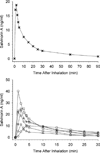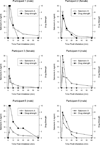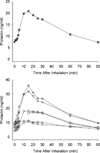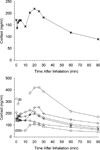Time course of pharmacokinetic and hormonal effects of inhaled high-dose salvinorin A in humans
- PMID: 26880225
- PMCID: PMC5289219
- DOI: 10.1177/0269881116629125
Time course of pharmacokinetic and hormonal effects of inhaled high-dose salvinorin A in humans
Abstract
Salvinorin A is a kappa opioid agonist and the principal psychoactive constituent of the Salvia divinorum plant, which has been used for hallucinogenic effects. Previous research on salvinorin A pharmacokinetics likely underestimated plasma levels typically resulting from the doses administered due to inefficient vaporization and not collecting samples during peak drug effects. Six healthy adults inhaled a single high dose of vaporized salvinorin A (n = 4, 21 mcg/kg; n = 2, 18 mcg/kg). Participant- and monitor-rated effects were assessed every 2 min for 60 min post-inhalation. Blood samples were collected at 13 time points up to 90 min post-inhalation. Drug levels peaked at 2 min and then rapidly decreased. Drug levels were significantly, positively correlated with participant and monitor drug effect ratings. Significant elevations in prolactin were observed beginning 5 min post-inhalation and peaking at 15 min post-inhalation. Cortisol showed inconsistent increases across participants. Hormonal responses were not well correlated with drug levels. This is the first study to demonstrate a direct relationship between changes in plasma levels of salvinorin A and drug effects in humans. The results confirm the efficacy of an inhalation technique for salvinorin A.
Keywords: Salvia divinorum; cortisol; endocrine; pharmacokinetics; prolactin; salvinorin A.
© The Author(s) 2016.
Conflict of interest statement
Financial Disclosures All authors report no biomedical financial interests or potential conflicts of interest.
Figures




Similar articles
-
Human psychopharmacology and dose-effects of salvinorin A, a kappa opioid agonist hallucinogen present in the plant Salvia divinorum.Drug Alcohol Depend. 2011 May 1;115(1-2):150-5. doi: 10.1016/j.drugalcdep.2010.11.005. Epub 2010 Dec 4. Drug Alcohol Depend. 2011. PMID: 21131142 Free PMC article. Clinical Trial.
-
Dose-related effects of salvinorin A in humans: dissociative, hallucinogenic, and memory effects.Psychopharmacology (Berl). 2013 Mar;226(2):381-92. doi: 10.1007/s00213-012-2912-9. Epub 2012 Nov 8. Psychopharmacology (Berl). 2013. PMID: 23135605 Free PMC article. Clinical Trial.
-
Lack of effect of sublingual salvinorin A, a naturally occurring kappa opioid, in humans: a placebo-controlled trial.Psychopharmacology (Berl). 2011 Apr;214(4):933-9. doi: 10.1007/s00213-010-2103-5. Epub 2010 Dec 8. Psychopharmacology (Berl). 2011. PMID: 21140258 Free PMC article. Clinical Trial.
-
From local to global-fifty years of research on Salvia divinorum.J Ethnopharmacol. 2014 Feb 3;151(2):768-83. doi: 10.1016/j.jep.2013.11.032. Epub 2013 Dec 4. J Ethnopharmacol. 2014. PMID: 24315983 Review.
-
Salvia divinorum and salvinorin A: an update on pharmacology and analytical methodology.Planta Med. 2007 Aug;73(10):1039-46. doi: 10.1055/s-2007-981566. Epub 2007 Jul 12. Planta Med. 2007. PMID: 17628834 Review.
Cited by
-
Chemical syntheses of the salvinorin chemotype of KOR agonist.Nat Prod Rep. 2020 Nov 18;37(11):1478-1496. doi: 10.1039/d0np00028k. Nat Prod Rep. 2020. PMID: 32808003 Free PMC article. Review.
-
Salvinorin A Inhibits Airway Hyperreactivity Induced by Ovalbumin Sensitization.Front Pharmacol. 2017 Jan 13;7:525. doi: 10.3389/fphar.2016.00525. eCollection 2016. Front Pharmacol. 2017. PMID: 28133450 Free PMC article.
-
Naltrexone but Not Ketanserin Antagonizes the Subjective, Cardiovascular, and Neuroendocrine Effects of Salvinorin-A in Humans.Int J Neuropsychopharmacol. 2016 Jul 5;19(7):pyw016. doi: 10.1093/ijnp/pyw016. Print 2016 Jul. Int J Neuropsychopharmacol. 2016. PMID: 26874330 Free PMC article. Clinical Trial.
-
Modular Approach to pseudo-Neoclerodanes as Designer κ-Opioid Ligands.Org Lett. 2017 Oct 6;19(19):5414-5417. doi: 10.1021/acs.orglett.7b02684. Epub 2017 Sep 14. Org Lett. 2017. PMID: 28910112 Free PMC article.
-
Preclinical Testing of Nalfurafine as an Opioid-sparing Adjuvant that Potentiates Analgesia by the Mu Opioid Receptor-targeting Agonist Morphine.J Pharmacol Exp Ther. 2019 Nov;371(2):487-499. doi: 10.1124/jpet.118.255661. Epub 2019 Sep 6. J Pharmacol Exp Ther. 2019. PMID: 31492823 Free PMC article.
References
-
- Addy PH. Acute and post-acute behavioral and psychological effects of salvinorin A in humans. Psychopharmacology. 2012;220:195–204. - PubMed
-
- Addy PH, Garcia-Romeu A, Metzger M, Wade J. The subjective experience of acute, experimentally-induced Salvia divinorum inebriation. Journal of Psychopharmacology. 2015;29(4):426–435. - PubMed
-
- Baggott MJ, Erowid E, Erowid F, Galloway GP, Mendelson J. Use patterns and self-reported effects of Salvia divinorum: an internet-based survey. Drug and Alcohol Dependence. 2010;111:250–256. - PubMed
-
- Baggott MJ, Erowid E, Erowid F, Mendelson JE. Use of Salvia divinorum, an unscheduled hallucinogenic plant: A web-based survey of 500 users. Clinical Pharmacology and Therapeutics. 2004;75:72.
Publication types
MeSH terms
Substances
Grants and funding
LinkOut - more resources
Full Text Sources
Other Literature Sources
Medical

